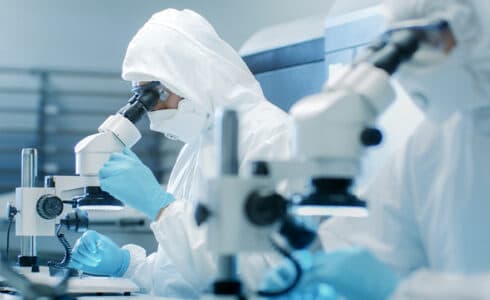Cleanroom 101
Welcome to Cleanroom 101, your ultimate guide to understanding and mastering the essentials of cleanroom environments. Whether you’re new to the concept or looking to deepen your knowledge, this section provides comprehensive insights into the design, maintenance, and operational protocols of cleanrooms.
Action Limit
An action limit is an established relevant measure (e.g. microbial, or airborne particle limits) that, when exceeded, should trigger an appropriate investigation and corrective action based on the investigation.
Source: EU GMP Annex 1
Air Changes Per Hour
Air changes per hour or the air change rate is the amount of time a cleanroom can completely replace its air volume within an hour. The higher the air changes per hour, the more effective it will be at removing contamination, therefore achieving a higher class. Often abbreviated to ACPH, ACH, or alternatively called Air Change Rate.
Air Showers
Air showers are enclosed chambers installed at the entrances of cleanrooms. They use high-velocity air jets to remove contaminants from personnel and equipment before entering the controlled environment. This ensures minimal particulate matter is introduced into the cleanroom.
Airborne Particle Counts
Airborne particle counts are an air sampling method, used to determine if a cleanroom is meeting the required particle concentration limits within its ISO 14644-1:2015 class parameters. They can be taken with a particle counter and will form part of a cleanroom validation check. They should also be taken regularly to ensure the cleanroom is still operating effectively between validations.
As-Built Cleanroom
An as-built cleanroom is a cleanroom that is complete, functional, and ready for operation, but without the equipment and personnel inside. Testing a cleanroom as-built reflects the quality of the supply air.
At-Rest Cleanroom
The definition of “at rest” state is the condition whereby the installation of all the utilities is complete including any functioning HVAC, with the main manufacturing equipment installed as specified but not operating and without personnel present in the room.
Source: EU GMP Annex 1
Cleanroom Classification
Cleanroom classification is a method of assessing the level of air cleanliness against a specification for a cleanroom or clean air equipment by measuring the total particle concentration.
Source: EU GMP Annex 1
Cleanroom Design and Construction
Designing and constructing a cleanroom involves careful planning and adherence to strict standards to control contamination. Factors to consider include airflow, filtration, materials, and layout.
Cleanroom HVAC Systems
Heating, ventilation, and air conditioning (HVAC) systems in cleanrooms are designed to control temperature, humidity, and airborne particle levels. These systems include HEPA and ULPA filters to maintain air quality and pressure differentials to prevent contamination.
Cleanroom Maintenance
Maintaining the cleanliness of a cleanroom requires rigorous and regular cleaning protocols. This includes daily, weekly, and monthly tasks to remove contaminants and ensure compliance with cleanliness standards.
Control System
A control system is designed to ensure that your Cleanroom operates at optimum effectiveness by constantly monitoring the operating conditions within the area, raising alarms if any of these parameters vary beyond a user-specified threshold. This enables environmental monitoring of controls such as pressure differential, particle counts, temperature & humidity with alarms flagged if there is an issue.
Differential Particle Counts
Particle counters display readings in two columns: differential (depicted by ∆ delta) and cumulative (depicted by ∑ sigma). The differential total shows the counts which are at least that size in diameter and up to, but not including the next size. The cumulative total shows the number of particles that were found at that size and greater.
Dewpoint vs Humidity
Dewpoint (dp) is the temperature that a volume of air reaches when it becomes saturated with water vapour, causing dew to form. Whereas relative humidity (RH) indicates the present state of humidity, relative to a maximum humidity given the same temperature. RH is often expressed as a percentage.
Door Interlock
Interlocked doors support good cleanroom entry and exit practices by only allowing one door to open at a time, preserving integrity. A magnetic lock on each interlocked door, with an integrated LED lock status indication, provides visual feedback on the current door status. With stainless steel infrared touchless proximity switches, activated by close proximity of the hand, there is no need to touch them, making them ideal for clean environments.
Essential Tools and Equipment
Various tools and equipment are necessary for cleanroom operations, including air showers, pass-through boxes, cleanroom furniture, and specialised cleaning supplies. These help maintain the controlled environment and prevent contamination.
GMP Cleanroom Standards
Good manufacturing practice (GMP) is the minimum standard that a medicines manufacturer must meet in their production processes. GMP cleanrooms and GMP manufacturing environments are designed to diminish the risks inherent to (bio)pharmaceutical production, such as viable and non-viable particulates, as well as cross-contamination. The environment is a core component of a Quality Management System and ensures that products are consistently produced and controlled to the quality standards appropriate to their intended use.
Gowning Procedures
Proper gowning procedures are essential to prevent contamination from personnel. This includes wearing appropriate cleanroom attire such as gloves, masks, coveralls, and shoe covers.
HEPA and ULPA Filters
High-Efficiency Particulate Air (HEPA) filters and Ultra-Low Penetration Air (ULPA) filters are used in cleanrooms to remove airborne particles. HEPA filters trap particles down to 0.3 microns, while ULPA filters capture particles as small as 0.12 microns.
HVAC
HVAC is an acronym for Heating, Ventilation, and Air Conditioning, so it relates to air handling.
ISO 14644-1 Requirements
ISO 14644-1 requirements describe contamination levels in terms of allowed air particulates in number and size. IEST Technical Guides serve as complementary documents to ISO Standards ISO 14644. They give guidance on recommended air change rates or airflow speed within the cleanroom and outline the necessary percentage of ceiling coverage for filtration.
ISO Cleanroom Standards
ISO cleanroom standards define the cleanliness levels required for different classes of cleanrooms, ranging from ISO 4 to ISO 9. Each class has specific limits for particle concentration and other environmental parameters.
Laminar Flow Units
These are specialised enclosures used to provide a particle-free work area within a cleanroom. They use HEPA or ULPA filters to supply a continuous flow of clean air, protecting both the product and the user.
Laminar Flow Cabinets
Vertical laminar flow cabinets/booths create either a localised clean environment or additional protection for critical processes within an existing controlled environment.
Materials and Surfaces
Cleanroom materials and surfaces must be non-shedding, easy to clean, and resistant to chemicals and disinfectants. Common materials include stainless steel, epoxy-coated surfaces, and specialised cleanroom-grade wall panels.
Modular Cleanroom
Modular cleanrooms are freestanding structures that can withstand the high volume of airflow required to achieve ISO classified, ultra-clean environments. The benefits of this modular approach mean that a cleanroom can evolve as demand increases as the layout, size, or shape can be changed to meet changing requirements, or the cleanroom can be relocated.
Monitoring and Testing
Continuous monitoring and regular testing of cleanroom environments are essential to ensure they remain within specified parameters. This includes particle counting, airflow measurements, and surface cleanliness testing.
Operational Cleanroom
A cleanroom that is complete, functional, and ready for operation, with the equipment and personnel inside. Testing a cleanroom operational allows for an accurate state of play to be observed.
Particle Counters
Particle counters are devices used to measure and count airborne particles in a cleanroom. These instruments help ensure that particle levels remain within acceptable limits as defined by cleanroom standards.
Pressure Differential
A pressure differential is a difference of pressure between points in a process system. Within the cleanroom industry, they are used to create pressure cascades to control the flow of contamination.
Proper Use and Maintenance
Ensuring that cleanroom equipment is used correctly and maintained regularly is crucial for its effectiveness and longevity. Training personnel and adhering to maintenance schedules can prevent equipment failure and contamination.
Training and Best Practices
Personnel working in cleanrooms must be thoroughly trained in contamination control, proper gowning procedures, and cleanroom protocols. This ensures they do not introduce contaminants into the controlled environment.
Transfer Hatches
Transfer Hatches are sealed compartments that allow materials to be transferred into and out of the cleanroom without compromising its cleanliness. They feature interlocking doors to prevent simultaneous opening, maintaining the controlled environment.
What is a Cleanroom?
A cleanroom is a controlled environment where the concentration of airborne particles is regulated to specified limits. These rooms are essential for various industries, including pharmaceuticals, biotechnology, and electronics, to prevent contamination and ensure product quality.



